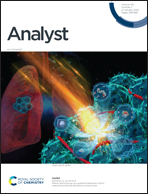Surface lanthanide activator doping for constructing highly efficient energy transfer-based nanoprobes for the on-site monitoring of atmospheric sulfur dioxide†
Abstract
The sensitive and on-site detection of sulfur dioxide (SO2) is in great demand in the fields of food safety and environmental protection. Here, we developed a novel upconversion nanoprobe based on the luminescence energy transfer mechanism for monitoring the atmospheric SO2 concentrations. The lanthanide emitters, Tm3+ ions, were optimized to be doped on the surface layer of the upconversion nanoparticles to improve their energy transfer efficiency by minimizing the distance between the emitters and the surface quencher, a cyanine dye. As a proof-of-concept, the optimal nanoprobe was utilized to detect SO2 water derivatives, bisulfite ions, exhibiting a linear luminescence increase in the range of 1 nM to 10 nM. Furthermore, we assembled the cyanine-modified upconversion nanoparticles onto a test paper, and used a smartphone-based detection platform to achieve portable and visual detection of SO2. The test paper showed a strong luminescence stability, homogeneity and good anti-interference. The limit of detection for SO2 gas was found to be 1 ng L−1. This novel upconversion test paper was also demonstrated to directly monitor the concentration of SO2 gas in atmosphere.



 Please wait while we load your content...
Please wait while we load your content...